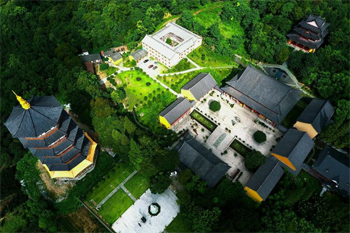The blessing tourism route encompasses the Asoka Ancient Temple, a 1700-year-old temple accommodating the Buddhist sarira, the Lingfeng Temple, a 1900-year-old temple serving once as the ashram of Ge Hong, and the Ruiyan Temple, a 1500-year-old temple billed as one of the three famous ancient temples in east Zhejiang. Newly constructed roads have linked the three temples to constitute a picturesque tourism route.
Asoka Ancient Temple

The Asoka Ancient Temple, initiated in the 3rd year of Taikang's Reign in West Jin Dynasty (282 A.D.), is acclaimed a Buddhist pearl because the sarira of Sakyamuni was once harbored here. In Wudi Emperor's reign of Liang Dynasty, it was encircled with wooden towers and awarded the "Asoka Temple" tablet. Most founders of the Japanese Buddhism sects once visited the Asoka Temple to communicate and learn the practicing methods, and a great many Japanese and Korean renowned Buddhists asked to place their remains in the temple in Tang and Song Dynasties. Currently, there are such cultural relics reserved in the temple as the Stupa of Master Huida, Buddhist Remains Pavilion, Ruiying Pavilion and Yongxian Rock Stele.
Address: Wushi'ao, Jiaxi Village, Daqi
Bus: Line 703-4
Lingfeng Temple

Formerly named as the Buddhism Ashram in Mingdi Emperor's reign in East Han Dynasty (58-75 A.D.), it was renamed so in the first year of Zhiping Reign in North Song Dynasty (1064 A.D.). It rivals White Horse Temple, the earliest temple in China, in popularity. Built in a deep valley and surrounded by mountains, the Lingfeng Temple embraces tranquil environment. Along the road leading to the temple and in surroundings of the temple, there are 12 scenic spots put in place by earlier residents. Monk Rune, abbot of the temple in Ming Dynasty, named these scenic spots as "Green Snow on Riverside Village", "9-turn Kudzu Vine", "Precipitous Single Summit", and "Fragrant Red Well". Lingfeng Temple is glorified for the coexistence of both Buddhism and Taoism. Apart from common buildings in other Buddhist temples, such as the Heavenly King's Hall and the Great Buddha's Hall, there's also the Master Ge's Hall enshrining the Taoist master, Ge Hong. Allegedly, when doing alchemy in the temple, Ge collected medical herbs to treat diseases for local residents. Worshipping him as a god, locals specially built a memorial temple for him. It's said there are the alchemy stove, alchemy well and square bamboo forest forming with chopsticks in the temple.
Address: Yanshan Road, Daqi
Bus: Line 703-3 (get off at Pioneer Village station and walk up the mountain)
Ruiyan Temple
 Built around 1500 years ago in the Tang Dynasty, Ruiyan Temple is billed together with Tiantong Temple and Asoka Temple as the three best-reputed temples in east Zhejiang. Wang Anshi once wrote a poem for it - The mountain is awash with verdant trees and birds are singing amid the gentle breeze coming from the valley entrance. Walking to the end of the 20km-long pine forest, you could find the temple at foot of the green mountain. The ancient temple has been well protected against the vicissitudes of time. After the reconstruction, Ruiyan Temple features a glamorous appearance with ancient trees towering to the sky and dense incense burning in the burner.
Built around 1500 years ago in the Tang Dynasty, Ruiyan Temple is billed together with Tiantong Temple and Asoka Temple as the three best-reputed temples in east Zhejiang. Wang Anshi once wrote a poem for it - The mountain is awash with verdant trees and birds are singing amid the gentle breeze coming from the valley entrance. Walking to the end of the 20km-long pine forest, you could find the temple at foot of the green mountain. The ancient temple has been well protected against the vicissitudes of time. After the reconstruction, Ruiyan Temple features a glamorous appearance with ancient trees towering to the sky and dense incense burning in the burner.
Address: Ruiyan Scenic Spot of Jiufeng Mountain
Bus: Lines 709-5 and 792


 Built around 1500 years ago in the Tang Dynasty, Ruiyan Temple is billed together with Tiantong Temple and Asoka Temple as the three best-reputed temples in east Zhejiang. Wang Anshi once wrote a poem for it - The mountain is awash with verdant trees and birds are singing amid the gentle breeze coming from the valley entrance. Walking to the end of the 20km-long pine forest, you could find the temple at foot of the green mountain. The ancient temple has been well protected against the vicissitudes of time. After the reconstruction, Ruiyan Temple features a glamorous appearance with ancient trees towering to the sky and dense incense burning in the burner.
Built around 1500 years ago in the Tang Dynasty, Ruiyan Temple is billed together with Tiantong Temple and Asoka Temple as the three best-reputed temples in east Zhejiang. Wang Anshi once wrote a poem for it - The mountain is awash with verdant trees and birds are singing amid the gentle breeze coming from the valley entrance. Walking to the end of the 20km-long pine forest, you could find the temple at foot of the green mountain. The ancient temple has been well protected against the vicissitudes of time. After the reconstruction, Ruiyan Temple features a glamorous appearance with ancient trees towering to the sky and dense incense burning in the burner.